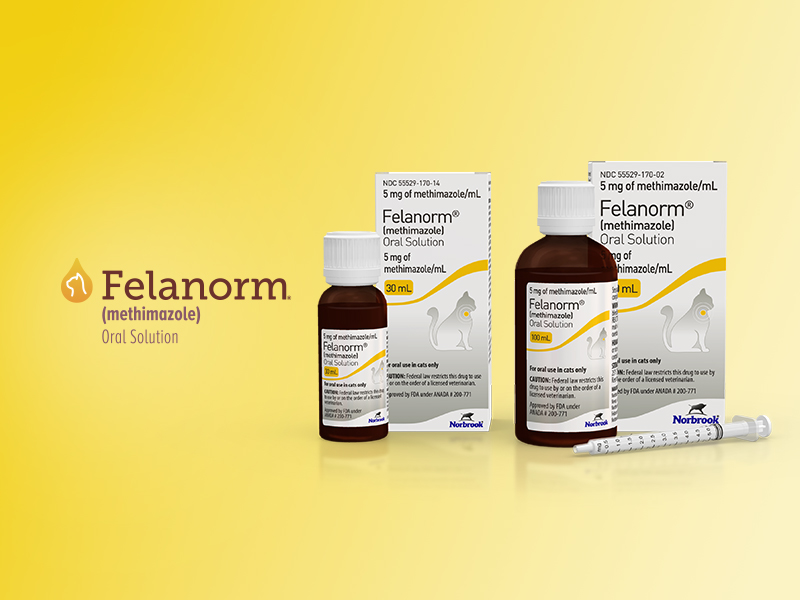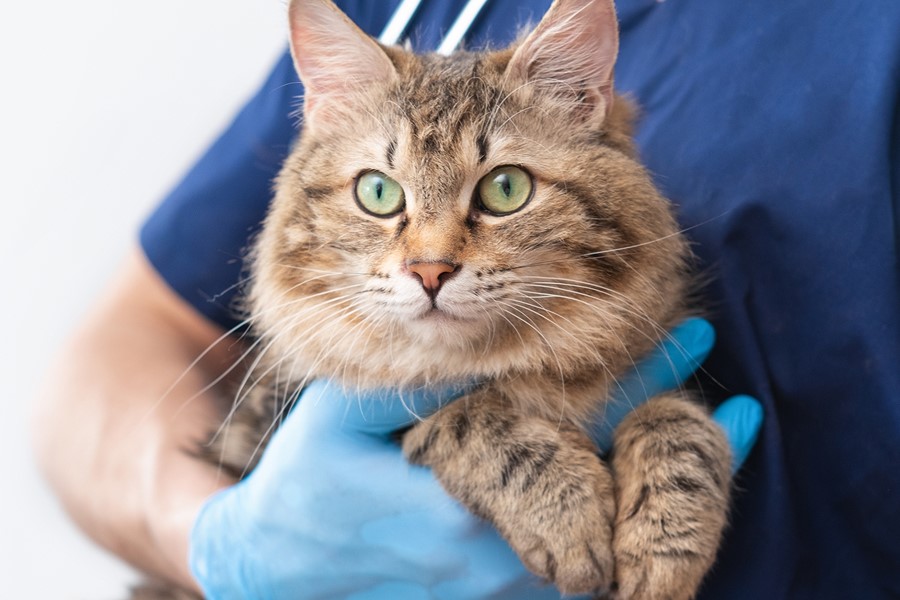Treatment of Hyperthyroidism in Cats
Hyperthyroidism is a common endocrine disease of geriatric cats, with approximately 10% of cats over 10 years of age developing hyperthyroidism.1,2 In approximately 98% of diagnosed cases, hyperthyroidism in cats is the result of a benign, but functional, thyroid adenoma. In approximately 1-3% of cases, a malignant tumor called a thyroid adenocarcinoma is responsible.1,2
The hyperthyroid cat has high levels of circulating thyroid hormones which affects metabolism and can have life-altering affects, so therapy is always recommended. There are several options for treating this condition ranging from those that are considered curative to those that manage the condition:
● Radioactive iodine therapy (131I)
● Thyroidectomy (surgical removal of the thyroid gland[s])
● Restricted iodine diet therapy
● Medical management with methimazole
Curative Feline Hyperthyroidism Treatment Options
Treatment for hyperthyroidism in cats includes two options that are considered curative, are irreversible and typically do not require any follow-up therapy: radioactive iodine therapy and surgical treatment.
Radioactive Iodine (131I) Treatment for Cats
The normal thyroid produces thyroid hormones, triiodothyronine (T3) and thyroxine (T4), and is subject to negative feedback. The presence of elevated circulating thyroid hormones causes both TRH (thyrotropin-releasing hormone) and TSH (thyroid-stimulating hormone) to decrease resulting in decreased output of thyroid hormones. When a functional thyroid tumor is present, the abnormal thyroid tissue continues to produce thyroid hormones independent of this negative feedback mechanism.
Dietary iodine is absorbed by the body and is used for the production of thyroid hormones (T3 and T4), which is the only known use of iodine by the body.1 When radioactive iodine (131I) is administered intravenously, it concentrates primarily in the abnormal thyroid tissue. Abnormal thyroid tissue anywhere in the body is thus irradiated and destroyed, while the normal thyroid tissue and surrounding tissues are typically spared, unless large amounts of radioactive iodine are administered.3 Recent studies have shown a decrease in post-irradiation hypothyroidism when a low-dose algorithm is used.4,5
Pros
● 95% cure rate1,2
● Kills abnormal thyroid tissue anywhere in the body
● No lifelong medication in most cases
● Serious adverse events are rare
● Minimal follow-up after treatment
Cons
● High initial expense
● 3-day to 4-week hospitalization
● Limited or no-contact confinement for ~ 2 weeks once home
● Owner must carefully collect and dispose of litter for 2 weeks
● Irreversible
● Potential permanent hypothyroidism
● Limited availability in some geographies
Thyroidectomy in Cats (Surgical Removal of the Thyroid Gland[s])
Thyroidectomy is another treatment option for hyperthyroidism in cats that has the potential to be curative. This was historically a very common procedure but has declined in frequency due to the availability of other treatment options.5 Hyperthyroid cats undergoing thyroidectomy are anesthetized for surgical removal of the affected thyroid gland or glands. There are increased anesthetic risks for hyperthyroid cats, so pre-treatment with medication to achieve euthyroidism is often recommended.6
Approximately 70% of cats have bilateral thyroid disease, so when both glands are removed, 90% of cats become euthyroid; this decreases to 30–65% when only one thyroid gland is removed.1 The thyroid glands are very closely associated with the parathyroid glands and are near nerves and vasculature in the neck, so the surgeon must be very cautious, as serious adverse effects are possible if the surrounding structures are damaged. Thyroidectomy does not address any ectopic thyroid tissue, which is present in approximately 4% of hyperthyroid cats.1,7
Pros
● Relatively simple procedure
● > 90% cure rate if bilateral gland removal1
● 35–60% if unilateral removal1
● Response within 24–48 hours
Cons
● Anesthesia risk to potentially compromised patient
● High initial expense
● May damage parathyroid glands
● Risk of hypothyroidism
● Irreversible
● Requires hospitalization
● Can alter “voice” due to nerve damage
Options for Long-term Management of Feline Hyperthyroidism
Alternative treatments for hyperthyroidism in cats are management options. These require lifelong therapy for the affected cat and will result in relapse if they are discontinued. Since these treatments also do not remove the thyroid tumor, there is a chance that over the lifetime of the cat, the benign tumor could become malignant.
Restricted Iodine Diet Therapy
Cats do not produce iodine; instead, they acquire iodine exclusively through their diet. Iodine is essential to the formation of thyroid hormones, so by restricting a cat’s consumption of iodine through their diet, thyroid hormone levels will decrease. Hill’s® has developed Prescription Diet® Thyroid Care - y/d® with restricted iodine content. When this diet was fed exclusively to hyperthyroid cats, approximately 83% became euthyroid within one year.1,8 Three-quarters of cats had significant improvements in symptoms and thyroid levels within four weeks of being fed this diet.9
This is a very simple solution for the management of hyperthyroidism, but it does require avoiding feeding most other foods and treats, which may be a limitation for picky eaters. This can also be much more difficult for households with multiple pets and is not an ideal option for cats that are allowed outdoors and may hunt.
Pros
● Response rate ~83% if diet exclusive1,8
● Easy (feed the cat)
● No drugs, no surgery
Cons
● Some palatability issues
● Must avoid most other foods and treats
● 100% relapse rate if discontinued
● Increased risk of adenocarcinoma with time
● Difficult in multi-pet household
Medical Management of Hyperthyroidism With Methimazole for Cats
According to a survey of 300 veterinarians, 88% of feline hyperthyroidism cases are managed with methimazole,10 the only drug approved for the treatment of hyperthyroidism in the United States. This is by far the most common therapy for hyperthyroidism in cats and is typically the first-line choice. Of the cats treated with methimazole, ~ 95% become euthyroid.
The recommended starting dose for methimazole is 2.5 mg/cat administered every 12 hours and is a daily, lifelong drug for hyperthyroid cats. Methimazole inhibits the function of the enzyme thyroid peroxidase, which is involved in the production of thyroid hormones.
Until recently, methimazole was only available as an FDA-approved tablet, a human generic tablet, or as a compounded oral or transdermal gel formulation. Because pilling a cat is often stressful to both the cat and the cat owner, transdermal methimazole gel has been a popular option. However, the absorption of methimazole through the skin of a cat’s ear is not consistent and increases the risk of exposure to humans and other pets in the household.15,16 In an effort to address these challenges, Norbrook® is excited to introduce Felanorm® (methimazole) Oral Solution, the first FDA-approved oral solution of methimazole.
Pros
● Response rate > 95% while on meds11–13
● No hospitalization
● No risk of permanent hypothyroidism
● Reversible
● Cost same but “distributed” over time
Cons
● Once or twice daily medication for life
● Frequent testing/adjustment required
● Increased risk of adenocarcinoma with time
● Adverse effects in up to 25% of cats1,14
● Elevated risk of human exposure with transdermal medication15
● 100% relapse rate if discontinued
Felanorm® (methimazole) Oral Solution for Cats

Felanorm is the first FDA-approved oral methimazole solution for the treatment of hyperthyroidism in cats. It is a honey-flavored liquid that was awarded the “Easy to Give” designation by the International Society of Feline Medicine.17
The Norbrook methimazole oral solution has been available in the U.K. since 2016, and in a 2024 survey of U.K. veterinarians using this product, 96% had received positive feedback from cat owners. More than 100 million doses have been sold in the U.K. alone since this product was introduced.18
Felanorm is available in 30 and 100 mL bottles and has a 2-year expiration date from the date of manufacture. It can be stored at controlled room temperature and requires no refrigeration.19 Please see the package insert for full prescribing information.
References
1 Carney HC, Ward CR, Bailey SJ, et al. 2016 AAFP Guidelines for the Management of Feline Hyperthyroidism. J Feline Med Surg 2016;18(5):400–416.
2 Peterson M. Hyperthyroidism in cats: what’s causing this epidemic of thyroid disease and can we prevent it? J Feline Med Surg 2012;14(11):804–818.
3 Peterson ME. Radioiodine Treatment of Hyperthyroidism. Clin Tech Small Anim Pract. 2006;21(1):34–39.
4 Xifra P, Serrano SI, Peterson ME. Radioiodine treatment of hyperthyroidism in cats: results of 165 cats treated by an individualised dosing algorithm in Spain. J Feline Med Surg 2022;24(8):e258–e268.
5 Peterson ME, Broome MR. Ultra-low doses of radioiodine are highly effective in restoring euthyroidism without inducing hypothyroidism in most cats with milder forms of hyperthyroidism: 131 cases. J Vet Intern Med 2014;28:1031.
6 Vaske HH, Schermerhorn T, Armbrust L, et al. Diagnosis and management of feline hyperthyroidism: current perspectives. Vet Med (Auckl) 2014;5:85–96.
7 Peterson, ME, Broome MR, Rishniw, M. Prevalence and degree of thyroid pathology in hyperthyroid cats increases with disease duration: a cross-sectional analysis of 2,096 cats referred for radioiodine therapy. J Feline Med Surg 2016;18(2):92–103.
8 Hui TY, Bruyette DS, Moore GE, et al. Effect of Feeding an Iodine-Restricted Diet in Cats with Spontaneous Hyperthyroidism. J Vet Intern Med 2015;29:1063–1068.
9 Van der Kooij M, Bečvářová I, Meyer HP, et al. Effects of an iodine-restricted food on client-owned cats with hyperthyroidism. J Feline Med Surg 2014;16(6):491–498.
10 Brakke, Veterinary Market Research: Interest in Felanorm. August 2023 (data on file).
11 Scott-Moncrieff JC. Feline hyperthyroidism. In: Feldman EC, Nelson RW, Reusch C, Scott-Moncrieff JC, editors. Canine and feline endocrinology, fourth ed. St. Louis: Elsevier Saunders;i 2015. p. 137–187.
12 Yu L, Lacorcia L, Johnstone T. Hyperthyroid cats and their kidneys: a literature review. Aust Vet J 2022;100(9):415–432.
13 Baral RM, Peterson ME. Thyroid gland disorders. In: Little SE, editor. The Cat: Clinical Medicine and Management. Philadelphia: Elsevier Saunders; 2024. p. 571–592.
14 Peterson ME, Kintzer PP, Hurvitz AI. Methimazole treatment of 262 cats with hyperthyroidism. J Vet Intern Med 1988;2:150–157.
15 Hill KE, Chambers JP, Jones BR, et al. Trans-pinnal movement of methimazole: an in vitro study showing that methimazole can cross from the inner to outer pinna of cats. J Feline Med Surg 2015;17(12)1005–1011.
16 Boretti FS, Sieber-Ruckstuhl NS, et al. 2014. Transdermal application of methimazole in hyperthyroid cats: a long-term follow-up study. J Feline Med Surg. 16: 453–459.
17 ISFM Easy-to-Give award 2017 (Note: Thyronorm® is the U.K. version of Felanorm; exact same formulation).
18 Kynetec Sales Data, U.K. (based on standard 2.5 mg dose).
19 U.K. Survey of veterinarians – February 2024, Data on File.
IMPORTANT SAFETY INFORMATION
CAUTION: As with all drugs, side effects may occur. The most commonly reported side effects are anorexia, vomiting, head/facial pruritus or edema, depression/lethargy, weight loss, anemia, elevated liver enzymes, skin lesions, elevated BUN, diarrhea, and thrombocytopenia. Felanorm® Oral Solution is not for use in pregnant or lactating queens, or cats with renal, hepatic, or hematological disorders. In some reported cases, the patients recovered after adverse signs were recognized, the drug was withdrawn, and veterinary care was applied. In some cases, death (or euthanasia) has been reported as an outcome of the adverse reactions listed above. Methimazole has anti‐vitamin K activity and may induce bleeding diathesis without evidence of thrombocytopenia. Refer to the prescribing information for complete details or visit www.norbrook.com.
US Patent Numbers: 10,045,967, US 11,123,327 and US 11,738,005
© 2024 Norbrook Laboratories Limited. The Norbrook logo and Felanorm are registered trademarks of Norbrook Laboratories Limited. 771-24-197









